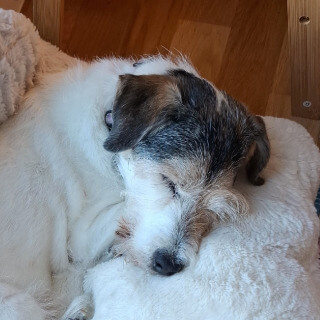Heart disease in dogs is serious.

Tracking it daily shouldn’t be.
Most veterinary cardiologists recommend monitoring your dog’s resting respiratory rate every day. Maven makes that simple, tracking your dog’s respiratory rate, heart rate, sleep, and activity to help you and your vet catch changes before they become crises.
Start from just $19.99/month (billed annually).
Sensor on us.
Built with veterinarians
Clinically validated
24/7 continuous tracking
Personalized to your pet
The everyday signs your dog’s heart might be struggling
Small and medium breeds are prone to mitral valve disease (MMVD), while large breeds often develop dilated cardiomyopathy (DCM) that compromises cardiac function. Either way, the first clues usually show up in how your dog breathes, rests, and moves.
Breathing faster at rest
When a dog is truly resting, you might notice the chest rising more than usual. A higher resting respiratory rate can signal fluid in or around the lungs.
Resting heart rate creeping up
Subtle increases over days or weeks matter. Trending up can be an early clue the heart is working harder.
Exercise intolerance
Shorter walks, more stopping, or skipping play. Parents often describe it as “he just seems tired” or “she won’t chase like before.”
Night restlessness or coughing
More wake-ups, pacing, or a soft cough that appears when settling down or after activity.
Belly or limb swelling
When the heart grows enlarged and can’t pump blood as it should, fluid can build up in the belly or paws, a sign often linked to congestive heart failure (CHF).
Sudden worsening is an emergency
The acute phase of these heart conditions is congestive heart failure (CHF). Rapid breathing at rest, severe lethargy, or collapse require urgent veterinary care.
You do your best, but it is easy to miss small shifts without help. That is exactly why Maven exists.
Turn “something feels off” into clear next steps
Maven learns your dog’s personal normal, then watches for meaningful changes. When something drifts, you get a friendly insight and what to do next.

Turn “something feels off” into clear next steps
Maven learns your dog’s personal normal, then watches for meaningful changes. When something drifts, you get a friendly insight and what to do next.
What Maven tracks and why it matters:
Looks for sustained increases that can suggest fluid build-up. You get context like “above your dog’s usual” instead of random numbers.
Watches for a persistent climb that may indicate the heart is under strain. Updates through the day when your dog is still.
Sees if walks are getting shorter or play is fading. Helpful for mitral valve disease (MMVD) and dilated cardiomyopathy (DCM), where stamina changes early.
Flags disrupted nights and clusters of wake-ups that often pair with cough or breathing effort.
Notes patterns around head shaking or increased drinking when relevant, without sending noise.

Peace of Mind for Pets with Heart Disease

The tracker is really impressive. My dog has heart disease, and I wanted a way to stop worrying about his breathing day to day. Maven has been the perfect solution. It’s already given me peace of mind, and I recommend it to anyone with an older pet or health concerns.
Backed by Veterinary Science
We’re not guessing, Maven’s accuracy is proven.
A clinical study published in the American Journal of Veterinary Research (2025) found that the Maven Pet Smart Collar’s resting respiratory rate readings were nearly identical to manual counts by veterinarians, with a difference of less than one breath per minute.
That means the data you see isn’t just smart tech, it’s clinically trusted insight that helps you and your vet spot early changes linked to heart disease.
FAQ's
While Maven helps you continuously monitor heart rate trends at home, it doesn’t perform electrocardiograms (EKGs) or replace diagnostic tools like a Holter monitor. Instead, it gives you and your vet valuable context between checkups, helping detect changes earlier.
Catch heart disease in dogs before it catches them.
Heart disease in dogs does not wait for your next appointment. Start tracking resting respiratory rate, resting heart rate, sleep, and activity today. See small changes early and walk into the clinic with confidence.



